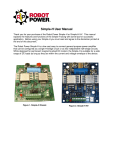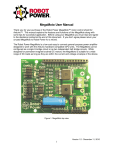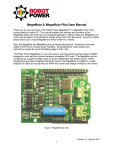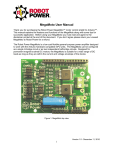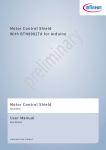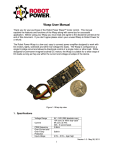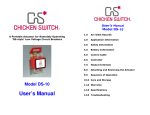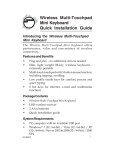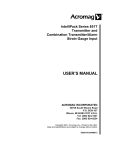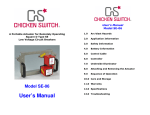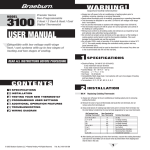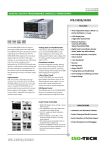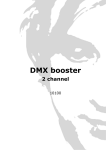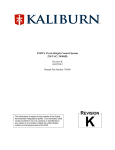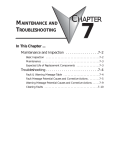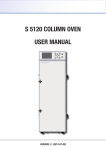Download Simple-H User Manual
Transcript
Simple-H User Manual Thank you for your purchase of the Robot Power Simple-H. This manual explains the features and functions of the Simple-H along with some tips for successful application. Before using your Simple-H you must read and agree to the disclaimer printed at the end of this document. The Robot Power Simple-H is a low-cost easy to connect general-purpose power amplifier that can be configured as a single H-bridge circuit or as two independent half-bridge circuits. While designed for permanent magnet brushed DC motors; the Simple-H is suitable for a wide range of DC loads as long as they are within the current and voltage envelope of the device. 1. Specifications Voltage Range Current (H1 bridge) Current (each halfbridge)* Current (ganged half-bridge)* PWM frequency Current Sense Output Input voltage levels PA,PB,EA,EB Size Weight Mounting Fan Without Fan 5V – 24V (28V absolute max) 20A cont. at 100% duty cycle 17A cont. at 70% 45A 5 second peak Same as above With Fan Same 25A cont. at 100% 20A at 70% 45A 5 second peak Same as above 40A cont. at 100% 35A cont. at 70% 70A 5 second peak DC – 20kHz Vc = I * 0.075 Vc = .0.75 at 10A Vc = 2.99V at 40A 2.5V – 5.5V = logic high <1.7V = logic low 48A cont. at 100% 38A cont. at 70% 70A 5 second peak DC-20kHz Same 2.5” x 2.25” x 0.5” 37g 4x - 4-40 or M2.5 bolts None 2.5” x 2.25” x 0.75” 61g Same 50mm x 10mm – 12V Same 1. Your actual current capacity will vary based on the type of load, the length and size of wires, power supply capability and other factors. 2. Input Output connections and Jumper Settings J1 Jumper Connections The Simple-H ships with two jumpers used to select the enable and current sense options of the unit. By default these are installed on EA and CA for combined enable and current sense operation (see below). If separate enable and/or current sense is desired the jumper should be moved to the EAB or CAB position. The jumpers should always be mounted in one position or the other. If they are not mounted the B-side power chip will not be enabled and/or the B-side current reading will not be available. The jumpers should always be placed across the rows of pins in line with the label on the PCB. EA EAB CA CAB EA input on CN1 enables BOTH power chips EA enables the M1 chip and EB enables the M2 chip CA output on CN1 reflects BOTH power chips (combined output) CA output reflects the M1 chip current and CB reflects M2 chip current CN1 is the primary control input/output connector for the unit. There is no electrical isolation between the power chips and the input connector so care should be taken when connecting to sensitive equipment. The Simple-H ships with either an 8-position screw terminal block in this position or various pin headers for specific user connector applications. The Screw terminal may be removed if desired and replaced with a 0.1” spacing pin header of the users’ choice. CN1 Input / Output Connections PA PB EA CA EB CB – + PWM-A input to M1 power chip may be pulse-width modulated or DC PWM-B input to M2 power chip Enable A & B when EA jumper is on or Enable A-side only when EAB jumper is on A-side (M1) current sense output if CAB is mounted or the combined current sense if CA is mounted. Enable-B only used if EAB is mounted Current sense B only used if CAB is mounted Battery negative (Ground) – Connect to signal source ground for voltage reference Battery positive - Output to external voltage regulator – Do not connect to an external battery or voltage source! 3. Application Configurations J1 EA J1 CA PA PB EA CA EB CB On On PWM Fwd PWM Rev Enable Current Sense N/C N/C J1 EAB J1 CAB PA PB EA CA EB CB On On PWM Motor 1 PWM Motor 2 Enable Mot 1 Current Mot 1 Enable Mot 2 Current Mot 2 J1 EA J1 CAB PA PB EA CA EB CB On On PWM M1 Tie to PA Enable Current A* N/C N/C * The current reading will only be for the current passing through the M1 power chip, which is ½ of the total. When connected, as an H-bridge the Simple-H is suitable for driving DC brushed motors both forward and reverse with variable speed. It may also be used to drive other bi-directional loads such as Peltier junctions, bi-directional solenoids, electromagnets and other DC loads. Pulse-width modulation may be applied to the inputs of the Simple-H to vary the average voltage applied to the load. Thus the Simple-H supports both variable speed and direction of a single load. Since the Simple-H supports 100% ON and OFF periods for the inputs, you may use mechanical or electrical switches or binary signals to activate the power chips. When switches are used the full battery voltage will be applied to the load at all times so no variation in speed is possible. When connected in half-bridge mode the Simple-H may be used for driving uni-directional loads such as lamps, heaters, solenoids or DC motors in one direction. The true half-bridge configuration of the power elements in the drive chips allow for efficient driving of loads with variable speed when compared to a single low- or high-side switch configuration with a recirculation (Schottky) diode. The Simple-H half-bridge drive features improved heat dissipation and current capacity along with temperature and current protection and current sensing. Both half-bridges may operate independently or they can be ganged together in parallel to support approximately double the current of the H-bridge or single half-bridge configuration. When driving DC motors it is important to understand the power switch configuration within the BTS7960B chip. As long as the enable line (EA or EB) is held logic high, the motor terminal (M1 or M2) is connected either to the B+ or B- terminal through the device. In an Hbridge configuration when both PA and PB are at the same logic level the load will be shorted through both the top switches and the positive battery rail or the bottom switches and the negative rail. This provides a strong “braking” action to the motor. To turn off both power switches the Enable (EA and/or EB) line must be pulled low. This is a freewheeling “coast” condition for the load. 4. Features The Simple-H uses the Infineon BTS7960B as its power-switching element. This chip contains two low-resistance complimentary MOSFET switching elements along with protection and driver circuits. Each BTS7960B thus contains a complete half-bridge and all needed driver circuits including robust protection features. The device features self-protection from over temperature, over current and over and under voltage conditions. As mentioned above the two half-bridge chips may be connected either as an H-bridge or as two independent halfbridges. This flexibility makes the Simple-H suitable for driving a wide variety of DC loads. The Simple-H features a current sense output from each half-bridge power chip. This output is a voltage proportional to the current flowing through the chip. The voltage output is approximately 0.075V per Ampere of current. When jumpered for individual current readings the CA and CB outputs reflect the current passing through the M1 and M2 motor terminals respectively. When jumpered for combined current output the CA output reflects the combined current flowing through both power chips. However, the current reading may not be negative so in an H-bridge configuration only the one power chip passing current in the positive direction (high-side switch on) will present an output; the other chip presents no voltage output. So in combined current mode the current output is correctly proportional to the current passing through the H-bridge. 5. Driving the Simple-H IMPORTANT you cannot simply connect the battery voltage to the EA, EB, PA and PB inputs through a switch. The maximum voltage level on these inputs is 6V. Connecting them directly to the battery voltage will damage the unit. The fan and the +/- positions on the screw terminal block are directly connected to the B+ and B- battery terminals. These are provided for convenience connections to the main battery. DO NOT ATTACH AN EXTERNAL BATTERY OR VOLTAGE SOURCE TO THESE. The Simple-H is completely self-powered and the main battery connection is all that is needed. The EA/EB and PA/PB inputs are inputs which control the output of the power chips in the Simple-H. The Simple-H inputs must be driven by 3V-5V logic-level signals. These voltage levels are compatible with nearly all microprocessors and controllers. Note, however that the Simple-H is not optically isolated from the command inputs so in the unlikely event of a total power chip failure it is possible that the full battery voltage could be applied to the command input pins. Protection devices are installed to limit the damage but users are advised to take precautions to protect the device controlling the Simple-H. It is recommended that you drive the load using the sign-magnitude method for H-bridge applications. This method allows the excess current to recirculate in the motor windings and reduces current feeding back into the power supply. If locked-antiphase drive is desired be aware that the power dissipation will increase especially in the main filter capacitor. This should be monitored carefully by measuring the temperature of the filter capacitor to make sure it is not getting hot when driving the load. The PWM frequency should be as high as possible when driving with this method to reduce the ripple current experienced by the load and the Simple-H. If regenerative braking of an inductive load such as a motor is desired it can be accomplished as follows: when slowing or reversing direction supply a low duty cycle drive to the load until the load has stopped or has reached a low RPM, then apply a brake or coast stop signal to the unit. The low average applied voltage of the low duty-cycle drive will allow the inductance of the load to boost the voltage at the battery terminals above the supply voltage and flow current back into the battery. Unfortunately the current sensors will not read properly during regeneration so the regeneration current level cannot be measured. Do not attempt regeneration with a bench power supply only with a battery. 6. Warnings The following warnings should be heeded when using the Simple-H to avoid failure of the device: 1. Bench type power supplies do not tolerate regenerative current i.e. current flowing back into the power supply. Often their voltage will increase until the extra power is dissipated. If the Simple-H is operated at 24V with a power supply of this type it is possible to exceed the 28V maximum rating of the device and destroy the power chips. When using a bench supply it is recommended that you operate at a lower voltage Adding a battery in parallel with the output of the bench supply will provide a buffer which can absorb the extra energy and avoid this type of failure. 2. Sensible driving of the load will increase the life of both the electronics and the motor. Do not repeatedly switch instantly from full forward to full reverse. If possible reduce the applied load voltage gradually by reducing the PWM duty cycle over the period of a few milliseconds. This allows the inductive energy in the circuit to dissipate without the inductive voltage “kick” that often occurs on abrupt interruption of the load current. When using a bench supply even switching from full speed to full stop may cause an inductive kick that can damage the device if the operating voltage is close to the upper limit. 3. Monitor the device temperatures. The power chips will protect themselves against overloads but repeated operation until the over temperature circuits are activated will shorten the life of the device. Add a fan to speed the cooling and increase current capacity. 4. When cooling the device a fan is the recommended method. The heatsink tabs are electrically connected to the motor outputs so the heatsinks must be isolated from each other (except in the ganged half-bridge mode). Fan cooling is effective even in an enclosed box so it may not be necessary to introduce outside air for effective cooling. 5. If the Simple-H is coated with conformal PCB coating products please ensure the heatsinks are masked and left free of coating. 6. Monitor the terminal connectors especially if fork type terminals are used. It is possible for them to twist and come in contact with the filter capacitor. If the filter cap is too close to the B+ and B- terminals it may be gently pushed back toward the heatsinks. It should have some clearance and not press tightly against the heatsinks because vibration may wear through the plastic coating and cause a short circuit. Tighten all screws securely and use thread locker if needed to ensure the terminal screws remain tight. Note, if the M1 and M2 connectors do twist and contact the heatsink that is not a problem since they are electrically connected anyway. 7. Attempting regeneration while the battery is fully charged may lead to larger than expected voltage rise at the battery possibly exceeding the maximum for the Simple-H. Many batteries have significantly increased impedance when fully charged. This can cause a large voltage spike when attempting to flow current into the fully charged battery. Once the battery has discharged some its impedance to reverse current should be much lower and regeneration can safely be used. 7. Dimensions and Mounting 8. Schematic The Simple-H schematic may be downloaded from the Robot Power Web site. www.robotpower.com/downloads/ 9. Further questions For questions not answered by this document or for application advice please feel free to contact us. We’ll be happy to answer your questions and hopefully together we can make your project using the Simple-H a big success. You can contact us at the following address: Robot Power 31808 8th Ave. S. Roy, WA 98580 USA 253-843-2504 [email protected] Thanks again for purchasing the Simple-H and best of luck with your projects. The Robot Power Team Disclaimer: The Simple-H is intended for educational and experimental uses. It should not be used in applications where human life or health or significant property value depend on its proper operation. Robot Power is not responsible for any loss or damage incurred by the operation or failure of this unit. We make no claims as to suitability or fitness for any application or use. The specifications listed for the unit are accurate to the best of our knowledge and testing but are not guaranteed in any way. The buyer assumes all responsibility for proper use, testing, and verification of this unit in any application. Robot Power’s liability is limited to replacement of defective DOA units. By installing and using this unit you are agreeing to these terms. If you do not agree you may return any unused units to Robot Power for a refund.








